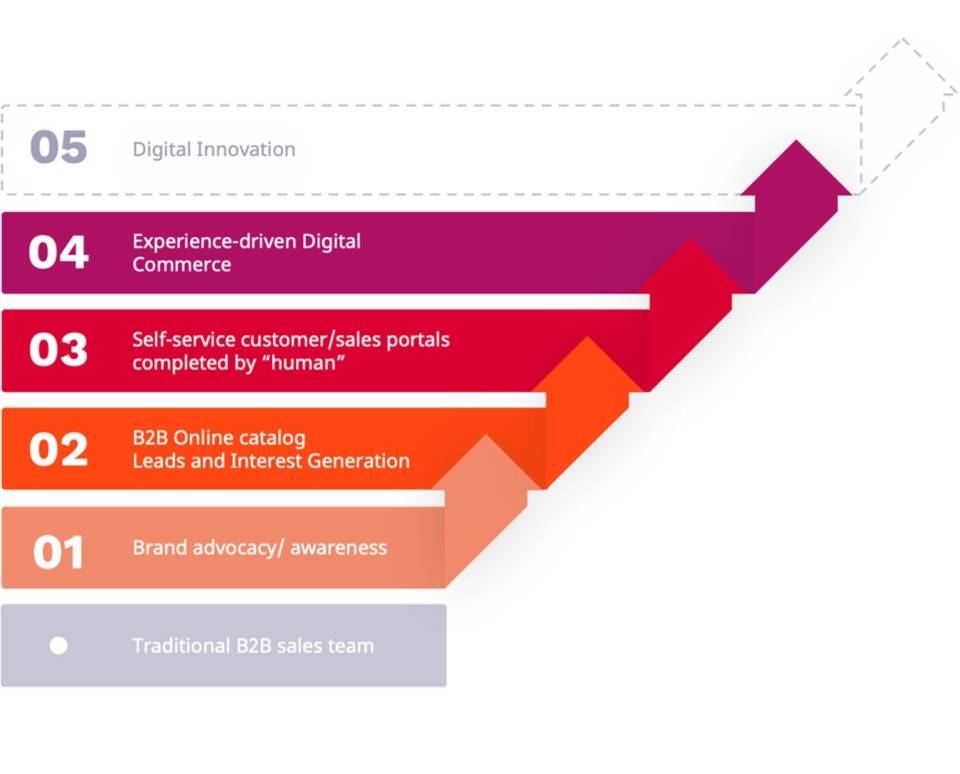Why Manufacturers Struggle to Sell Complex Products Online, and How to Overcome it

Manufacturers sell more products, at more highly differentiated prices, to a wider distributional network than any other type of commercial enterprise. It comes as no surprise, therefore, that manufacturing has struggled to take full advantage of the possibilities of B2B commerce.
Looking back 20 or even just 10 years ago, the “solutions” to take manufacturing sales online weren’t up to the task. Today, we have that technology, yet most manufacturers are unsure where to start.
In manufacturing, all roads lead to the product catalogue, and the product catalogue lies at the heart of what makes B2B commerce so challenging for manufacturers.
Of course, most will have digitized their catalogues and made them available on the website. But often, these online catalogs proved as static in their functionality as the thick printed ones that were the product bible of all manufacturers before the arrival of digital technology.
Analog product catalogs become outdated the moment they are printed. However, if you struggle to update product information across your website(s), your digitized catalogue is not a transformational advance on what you were doing before.
Print catalogs are impractical because in manufacturing it is the rule rather than the exception to have many thousands of SKUs. In the bad old days, customers might have to flick through hundreds of pages to find the right SKU; in B2B commerce, this has been replaced by product search which certainly speeds things up. But if the searches on your website routinely yield inaccurate or incomplete results, then you have not fully leveraged the potential of your digital investment.
This is where many manufacturers find themselves today – 10 or 15 years after they launched their sites and digitized their catalogues. They are successful, and respected in their sector, with state-of-the-art production facilities, yet unable to make ecommerce truly a game-changer.
Most manufacturers do want to achieve success online but struggle to manage this with the products they have, and with the pricing and distributional infrastructures already in place.
In most digital transformation projects, a huge component of change centers around the catalog: how to search it, how to customize it, how to update it, and how to enrich it with information about price and stock position. This is not a transformation that can be achieved overnight or in a single project.
So, the focus of our article will be on how you can leverage the power of your product catalogue to reach your strategic objectives and give your customers a compelling reason to interact with you online (which is what they all want).
Many things make a product "complex", and we should begin not with a definition (there isn't one) but with a description of why certain products do not lend themselves easily to B2B commerce.
We then describe how manufacturers can implement a strategy of digital transformation with a composable, phase-based approach supported by a Digital Experience Platform (DXP). Finally, we analyze how two manufacturers placed their product catalogues at the dynamic heart of their B2B commerce implementation.
What makes a product complex?
It is not the nature of the product that makes it immediately complex or simple. CheMondis, a marketplace for chemicals, sells highly regulated and dangerous products. Cost isn’t necessarily a factor either. According to McKinsey’s post-pandemic survey of B2B decision makers, one in three is now relaxed about spending more than $500,000 on remote or self-service channels for a single interaction.
A lot of the complexity arises from the fact that manufacturers typically offer products that are highly configurable at prices that can vary markedly from one distributor to the next across markets with different compliance regimes.
If we unpack that a little, it breaks down as follows:
- Product configuration. Business-to-business purchases are often part of an extended chain of production; the relationships between orders X, Y, and Z can be highly technical. What’s the role of your sales reps in a context where buyers want to be autonomous and self-reliant?
- Product catalogues. Manufacturers often sell many tens of thousands, if not hundreds of thousands, of SKUs. How do you present this information and make it searchable? WordPress-type backends struggle under the weight of a substantial product catalogue and don't integrate well at all with Product Information Management (PIM) solutions. This is why manufacturers are abandoning WordPress-type solutions for DXPs that give them many more options.
For example, interrogating a database with hundreds of thousands, if not millions, of SKUs is a source of friction for buyers interested in just part of your assortment. DXPs are intuitive in creating custom catalogues, which are a form of personalization – a clear advance on “pure” B2B commerce tools that struggle to segment the product information they are required to handle.
- Product pricing. If you buy a contact lens cleaning fluid on Amazon you pay the same price as everyone else, unless you buy 10 bottles, or click on the “Subscribe & Save” option (which means, effectively, that three products are on offer, each with a fixed price). But manufacturers have long-standing and complicated contractual relationships with distributors and resellers that must be captured on the platform for ecommerce to truly work. Again, this is where systems originally built for the B2C market fall short.
- Product markets. Manufacturing exporters are used to modifying their products to suit different markets, and so the reflex action when it came to ecommerce has usually been to create discrete sites for each of those markets (and languages). But this has led to a digital drift where manufacturers begin to lose control of their branding and waste a lot of time updating content across many sites (and languages). None of the CMS solutions on which these satellite sites are usually built are capable of resolving this complexity.
In our next section, we explore how DXPs defuse these challenges and create a path toward enablement for complex B2B commerce.
The B2B path of digital transformation
Not all manufacturers have the ambition to commit to full, transactional ecommerce.
The German maker of locks and security systems ABUS could easily sell a large part of its assortment directly but it made the strategic decision to stick with its established distributional model. So, in terms of the digital journey described in the graphic below, ABUS “skips” the Digital Commerce phase (at least for now), but not phase 5 that follows, Digital Innovation, because you want your DXP to be completely future-proof across all use cases.
We do not have the scope here to analyze fully how this digital roadmap relates to the technological capabilities progress through these phases. We need to highlight two things for now: that a lot needs to happen before a manufacturer can sell its complex products online, and secondly, that you must get there in steps – as they are broken down here.
These steps towards digital maturity find their counterpart in the modular architecture of the so-called “composable DXP” which enables manufacturers to grow towards ecommerce organically and to stagger investment in line with that technological journey.
How does a composable approach address the problems around B2B commerce for the manufacturing sector?
As we saw, the principal pain points revolve around catalogues and pricing. Below we explore, briefly, how a composable DXP helps manufacturers to overcome these challenges:
- Product Information Management (PIM). DXPs with their roots in content management typically have strong backend capabilities, with some powerful enough to replace third-party PIM solutions. In addition, some vendors have added a native PIM as part of their composable offering. Manufacturers with extensive product catalogues deploy DXPs that can “slice up” or segment the data flexibly and powerfully to build custom catalogues for discrete customer personas. Advanced search functionalities allow customers to configure products intuitively, although there will always be a place for sales reps to add value with timely intervention in the customer experience.
- Product pricing. Integration with the core ERP system (or, in some cases, systems) feeds real-time and segmented data about price and inventory to the website. Modern standalone ecommerce solutions also allow for this, but there are a handful of DXPs on the market that give access to this do-or-die information in the research phase. It is nonsense to exclude price/inventory data from the earlier phases of the purchasing journey because even the “right” product is completely wrong if it is out of stock, or not competitively priced. The capability to provide this information is a significant differentiator. It should be allied with a powerful recommendation engine that presents the buyer with smart options to source the same product from a different warehouse (and with a different delivery date), or to order an alternative product at a more attractive price point.
We shall conclude by looking at two brands that are leveraging a DXP to implement B2B ecommerce for their complex products.
How two manufacturers made their product catalogs transformative
Dymax
US manufacturer Dymax is a world leader in adhesive, coating, fluid dispensing, and light-curing systems for applications in a wide range of markets. It decided to re-platform away from WordPress, which could not handle the complexity of its vast product catalog and its presence across many markets with different regulatory regimes. Dymax plans to eventually start selling online and therefore selected a DXP that would enable it to do so without the need for further development.
But first, it had to digitalize its product catalogue.
The main innovation of the Dymax relaunch on a DXP was an intuitive product finder. In just a few clicks, customers are directed to the right industry application, the right product, and the right product formulation for the regulatory jurisdiction of the market where the product will be used. Product quotations and test sample orders are seamless extensions of this rapid and transparent search function which takes its data not from a third-party PIM but from the backend of the platform.
The first phase of this digital journey helps the customer to get information quickly and use it flexibly. It also sets up Dymax for more innovation down the line.
Delabie
DELABIE is the leading European supplier of tap and sanitaryware for public spaces such as airports, sports stadia, schools, offices, restaurants, and hospitals. The manufacturer had a great, award-winning B2B website but wanted to do better, particularly with its catalogue of 2,000+ products.
It re-platformed to a DXP to better serve a larger digital footprint which had grown from two sites and two languages in 2015, to nine sites and 10 languages on the eve of the relaunch. New subsidiaries in Dubai and Hong Kong meant that DELABIE was working across different time zones, and this had repercussions for product marketing as content changes were uploaded overnight — that is to say when it was night in Europe. But not in the Middle East or Asia.
This was not the only issue. Product updates were conducted manually in Microsoft Excel which made life hard for DELABIE’s 19 content editors. Importing changes to the sites was slow and disruptive, and product information was updated just once a month. Unacceptable.
On the new site, supported by a DXP, such changes can be imported across the digital estate in a matter of seconds without causing the Dubai and Hong Kong sites to be shut down.
This was not the only product catalogue transformation.
Product searches and filters are more intuitive and complete, with smart links to a huge range of documentation. This is useful internally for DELABIE’s product sheets, and for creating personalized catalogues to accompany its offers.
The new site is more finely attuned to the needs of DELABIE’s different target groups: distributors and wholesalers, as well as the architects and design agencies that recommend DELABIE products as part of their plans.
Wholesalers can import photographs and product descriptions from the DELABIE site to create their own personalized catalogues. Architects and designers can now easily find and select 3D files, personalized catalogues, reports with technical specifications, and DELABIE installation instructions and integrate them seamlessly with their dossiers. In this way, the quality of the product and the quality of the customer experience merge, which was the objective of DELABIE’s digital team.
The Dymax and Delabie use cases are examples of how DXPs are helping manufacturers to leverage innovation to make their product catalogues work much harder and bring them closer to their customers.
Of course, there are many other aspects of digital transformation such as integration with the ERP for custom pricing and real-time inventory information or a Customer Data Platform (CDP) to consolidate data sources and build that 360º view of your customer, not to mention ecommerce functionalities to make your site transactional.
But the basis for transformational change is the product catalogue.
Conclusion
We kicked off trying to define a “complex product”. We now see that one answer to that question is: products that have outgrown their CMS and have their natural home in advanced DXPs with a clear development roadmap, focused on B2B commerce.
Such a roadmap must be strategically oriented towards capturing the everyday business processes that make B2B commerce so complex and elusive. Manufacturers are often overwhelmed by its complexities, but they understand their product catalogues better than anyone else.
This is why the first steps on that journey must be to grasp the digital potential of the product catalogue – and then to make those possibilities come true.
Discover how we can help you with your Digital Transformation
Book a meeting with an Expert
Let's talk about how we can help you. From a 15-minute discovery call to a short demo of our technology, we can advise and recommend the right solution at all stages of your digital transformation.

